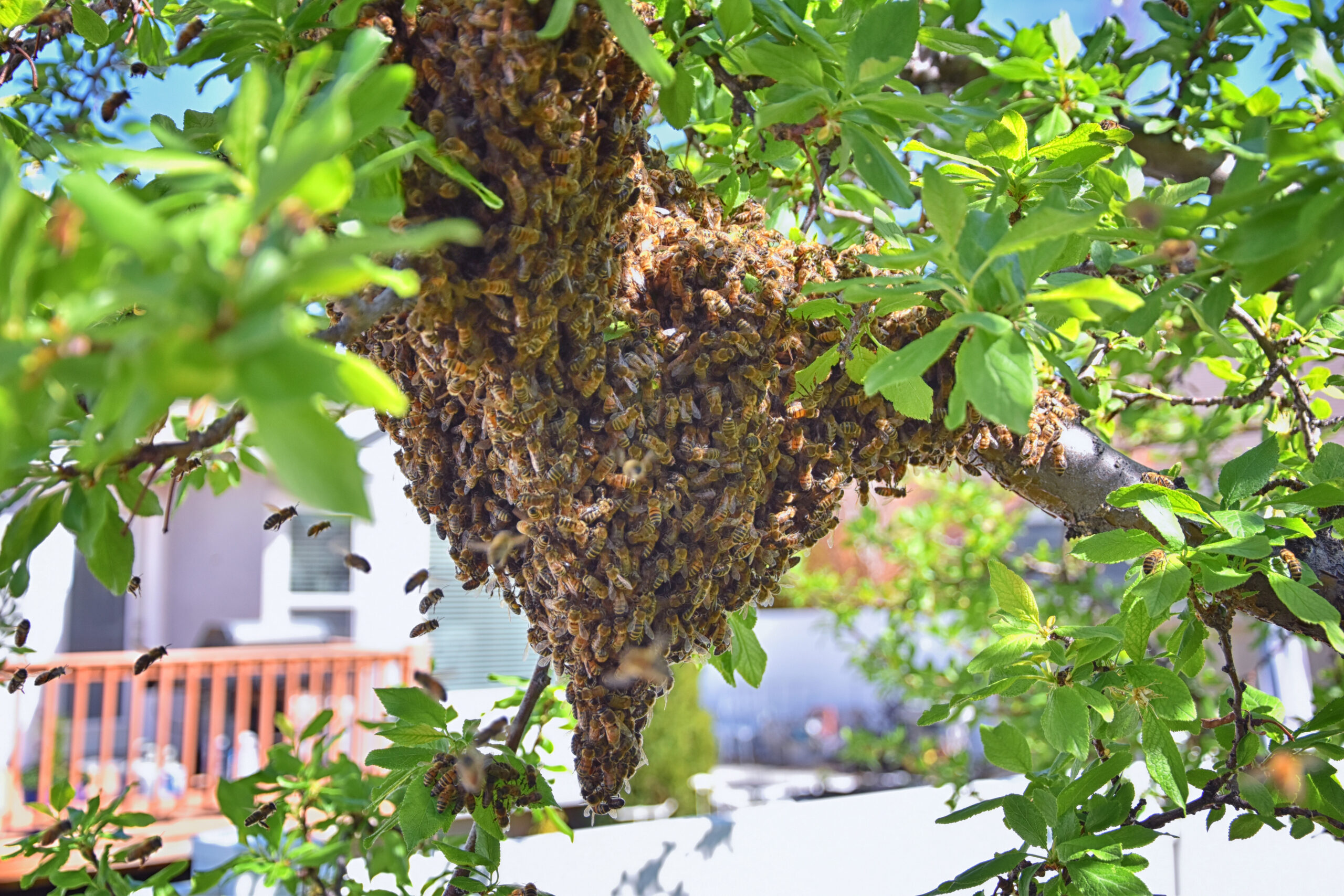How The “Bee Guy” Saved An MLB Game From A Honey Bee Swarm
How The “Bee Guy” Saved An MLB Game From A Honey Bee Swarm
Baseball season is in full swing (pun absolutely intended), and fans across the country are happily preparing for months of exciting games and record-breaking wins. Spring is a great time of year for a ball game, but ball players and fans aren’t the only ones enjoying this season.
Out of all the active insects this time of year, the bee is one of the busiest (we’re on a roll here). It spends the spring searching for flowers and swarming with their colonies. The latter habit was on full display earlier this week at the Diamondbacks-Dodgers game in Arizona, where a full swarm delayed the game for almost two hours! Let’s discuss how a pest control icon saved the day and why bees feel the need to swarm in the first place.
The Bee-Baseball Battle

The swarm of bees responsible for the delay. Photo: Still from MLB video coverage.
Picture it: Arizona, April 30, 2024. The seats at Chase Field are filling up with cheerful fans as their favorite players warm up on the diamond below. The air is coated with the aroma of fresh hot dogs and loaded fries. The sea of Diamondbacks and Dodgers jerseys is waiting with anticipation for the second game of the series to start. But then, the Events team notices a few too many bees buzzing around home plate…
Before the ceremonial first pitch was even thrown, Diamondbacks staff called Mike Rock, the Diamondbacks VP of Operations, to tell him that a swarm of bees was gathered on the top of the net behind home plate. Rock took immediate action by notifying the managers of the issue and calling Blue Sky Pest Control for an emergency bee removal. This was the best course of action because all it would take is one foul ball bouncing off the net to make the cluster of bees scatter and become aggressive.
After making the call, everyone prepared for the pest control specialist’s arrival. Fans seated in the sections behind home were requested to temporarily relocate. The Diamondbacks issued a statement saying that the game was delayed because the bees in the net needed to be professionally removed. Everyone in the stadium waited to see the brave soul that would remove the bee colony and save the day. Enter: the “Bee Guy.”
Bravo, “Bee Guy!”

Matt Hilton throws out the first pitch. Photo: Christian Petersen/Getty
Matt Hilton of Blue Sky Pest Control later stated he left his son’s tee-ball game as soon as he got the desperate call. He told the staff about the tools and setup he would require, like a scissor lift to get him up to the colony, as he sped off to Phoenix. Once he arrived, Hilton was driven onto the field in the cart while the crowd gave a standing ovation for their new hero. He donned his protective gear and brought his equipment onto the lift, raising his hands to keep the fans hyped up.
Hilton first sprayed the bees with a mild product to temporarily stun them, then vacuumed them up with his specialized vacuum. The attendees continued cheering and filming Hilton’s work on their phones while “Holding Out for a Hero” by Bonnie Tyler blared through the sound system. When the majority of the bees were removed and Hilton was lowered down, chants of “M-V-P! M-V-P!” filled the air like the ending of a classic sports film. The Diamondbacks displayed a now-iconic statement on the Jumbotron: “Thank You Bee Guy.”
Hilton’s night of heroism didn’t end there. The Diamondbacks staff showed their appreciation for his hard work by inviting him to throw out the ceremonial first pitch! Hilton delivered a strong throw to more cheers, smiling the whole time he was on the field. After another 30 minute delay to ensure that the remaining bees were gone (per Hilton’s recommendation), the game started almost 2 hours after its original start time. Diamondbacks fans might consider the “Bee Guy” their new lucky charm: they won 4-3 when Christian Walker hit a walk-off home run in the 10th inning!
In Hilton’s own words, he was surprised by the crowd’s support: “I thought I was here to just take care of a bee problem, and people were pretty hyped up. It was pretty cool” (MLB, 2:41-2:48). From all of us in the pest control world, congratulations and a job well done to Matt Hilton! The “Bee Guy” is a great legacy to leave in the entertaining world of baseball.
Why Do Bees Swarm?

So, after that entertaining story, there’s still the question of why bees swarm in one spot like that. After all, don’t bees want to stay in their own hives? It’s actually pretty common for bees to swarm in the spring — this wasn’t the first MLB game delayed by bees — when it’s not raining. Swarms like this can last for a few hours or several days, so it’s great that Hilton removed this one in a timely manner.
Honey bees keep their hives in tree cavities, shrubs, abandoned rooms or buildings, and light poles. They forage the surrounding area for the abundant pollen and nectar in this season, bringing enough back to feed their colony and make sweet honey. But even bees can outgrow their original home, which causes them to swarm until they can find a new one. There are two main reasons why bees swarm in one spot: overcrowding and uninhabitable hives.
Overcrowded Hive
Since the queen bee lays eggs every day, the colony grows at a steady rate throughout the warmer months. The workers spend time patching and cleaning the hive, but even they can’t expand it enough to fit all of the new bees (or newbies…get it?). Once the hive is deemed overcrowded, the workers split into two groups. One will stay in the original and the other will find a new habitat for their team. They keep their queen slim and prevent her from laying eggs so she can fly to the new habitat.
Uninhabitable Hive
Similar to a house, a beehive can become uninhabitable if the conditions are rough enough. Honey bees will leave their hive if there’s no food or water, a constant disturbance, a disease, adverse weather, or bad ventilation. The queen can release certain pheromones (scent chemicals) when she wants the colony to vacate the hive. All of the bees leave and protect one another while they find a place to swarm until they move into a new habitat.
The Process Of Leaving

We don’t know why the bees swarmed the net at Chase Field, but they still displayed the same behavior as any other swarming colony. The queen is kept in the center for maximum protection, as she is the only one capable of reproducing until the newborn queens are mature. The queen’s pheromones instruct her workers to cluster together and defend the colony.
Several scout bees search the area for a new nesting location while the rest of the colony swarms together. The scouts can travel over a mile if they need to, as they need to be picky with the spot that they will build the new hive upon. Once the scouts locate a new spot and report it to the colony, the whole swarm flies together to protect their numbers as they move into their new home. We can only wonder if any scout bees found a new habitat somewhere in the baseball stadium, or if they preferred to get away from the excitable Diamondbacks and Dodgers fans.
Green Is The Winning Team
Bee swarms aren’t the only pest problem plaguing local homes and business this spring. The blossoming plants and warm weather coax pests out of hiding, which is why they need to be met with efficient treatments from Green Pest Services. Our licensed technicians are prepared to solve any of your pest issues with the utmost care and efficiency every time. We eliminate pests with a combination of thorough inspections, efficient treatments, and preventative solutions. Don’t let pests take the fun out of your spring: contact us today for a free quote on our grand slam pest control services!
Citations
Gilbert, S. & Reynolds, M. (2024, May 1). Pest control hero saves Dodgers-D-backs game from bees. MLB. Available at (Accessed on May 1, 2024, from https://www.mlb.com/news/dodgers-diamondbacks-bee-delay
Jepsen, R. (2019, May 27). Why bees swarm and what you should — or shouldn’t — do about them. UC Master Gardeners of Santa Clara County. Available at https://ucanr.edu/blogs/blogcore/postdetail.cfm?postnum=30352 (Accessed on May 1, 2024).
Longmire, B. (2024, May 1). ‘Bee guy’ who removed hive from MLB game wins over crowd, gets first pitch: ‘Pretty hyped up.’ People. Available at https://people.com/bee-guy-removed-hive-mlb-game-first-pitch-8641626 (Accessed on May 1, 2024).
Piecoro, N. (2024, May 1). ‘Thank you bee guy’: How the Diamondbacks handled swarm at Chase Field. AZCentral. Available at https://www.azcentral.com/story/sports/mlb/diamondbacks/2024/05/01/arizona-diamondbacks-bees-chase-field-matt-hilton/73523295007/ (Accessed on May 1, 2024).
Powell, B. (2020, March 27). Frequently asked questions about honey bee swarms. Clemson Cooperative Extension: Home & Garden Information Center. Available at https://hgic.clemson.edu/factsheet/frequently-asked-questions-about-honey-bee-swarms/ (Accessed on May 1, 2024).
The Associated Press. (2024, May 1). Bee swarm delays MLB game nearly 2 hours. Nester Media Wire. Available at https://www.nxsttv.com/nmw/news/bee-swarm-delays-mlb-game-nearly-2-hours/ (Accessed on May 1, 2024).
MLB. (2024, April 30). BEE DELAY! 🤣🤣 (Beekeeper shows up and saves the day!) [Video]. YouTube. https://www.youtube.com/watch?v=HTCQ6lAB_rg

